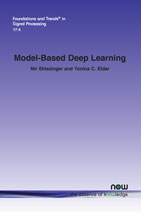Model-Based Deep Learning
By Nir Shlezinger, School of Electrical and Computer Engineering, Ben-Gurion University of the Negev, Israel, nirshl@bgu.ac.il | Yonina C. Eldar, Faculty of Mathematics and Computer Science, Weizmann Institute of Science, Israel, yonina.eldar@weizmann.ac.il
Abstract
Signal processing traditionally relies on classical statistical modeling techniques. Such model-based methods utilize mathematical formulations that represent the underlying physics, prior information and additional domain knowledge. Simple classical models are useful but sensitive to inaccuracies and may lead to poor performance when real systems display complex or dynamic behavior. More recently, deep learning approaches that use highly parametric deep neural networks (DNNs) are becoming increasingly popular. Deep learning systems do not rely on mathematical modeling, and learn their mapping from data, which allows them to operate in complex environments. However, they lack the interpretability and reliability of model-based methods, typically require large training sets to obtain good performance, and tend to be computationally complex.
Model-based signal processing methods and data-centric deep learning each have their pros and cons. These paradigms can be characterized as edges of a continuous spectrum varying in specificity and parameterization. The methodologies that lie in the middle ground of this spectrum, thus integrating model-based signal processing with deep learning, are referred to as model-based deep learning, and are the focus here.
This monograph provides a tutorial style presentation of model-based deep learning methodologies. These are families of algorithms that combine principled mathematical models with data-driven systems to benefit from the advantages of both approaches. Such model-based deep learning methods exploit both partial domain knowledge, via mathematical structures designed for specific problems, as well as learning from limited data. We accompany our presentation with running signal processing examples, in super-resolution, tracking of dynamic systems, and array processing. We show how they are expressed using the provided characterization and specialized in each of the detailed methodologies. Our aim is to facilitate the design and study of future systems at the intersection of signal processing and machine learning that incorporate the advantages of both domains. The source code of our numerical examples are available and reproducible as Python notebooks.
Model-Based Deep Learning
Signal processing traditionally relies on classical statistical modeling techniques. Such model-based methods utilize mathematical formulations that represent the underlying physics, prior information and additional domain knowledge. Simple classical models are useful but sensitive to inaccuracies and may lead to poor performance when real systems display complex or dynamic behavior. More recently, deep learning approaches that use highly parametric deep neural networks (DNNs) are becoming increasingly popular. Deep learning systems do not rely on mathematical modeling, and learn their mapping from data, which allows them to operate in complex environments. However, they lack the interpretability and reliability of model-based methods, typically require large training sets to obtain good performance, and tend to be computationally complex.
Model-based signal processing methods and data-centric deep learning each have their pros and cons. These paradigms can be characterized as edges of a continuous spectrum varying in specificity and parameterization. The methodologies that lie in the middle ground of this spectrum, thus integrating model-based signal processing with deep learning, are referred to as model-based deep learning, and are the focus here.
This monograph provides a tutorial style presentation of model-based deep learning methodologies. These are families of algorithms that combine principled mathematical models with data-driven systems to benefit from the advantages of both approaches. Such model-based deep learning methods exploit both partial domain knowledge, via mathematical structures designed for specific problems, as well as learning from limited data. The monograph includes running signal processing examples, in super-resolution, tracking of dynamic systems, and array processing. It is shown how they are expressed using the provided characterization and specialized in each of the detailed methodologies. The aim is to facilitate the design and study of future systems at the intersection of signal processing and machine learning that incorporate the advantages of both domains. The source code of the numerical examples are available and reproducible as Python notebooks.
